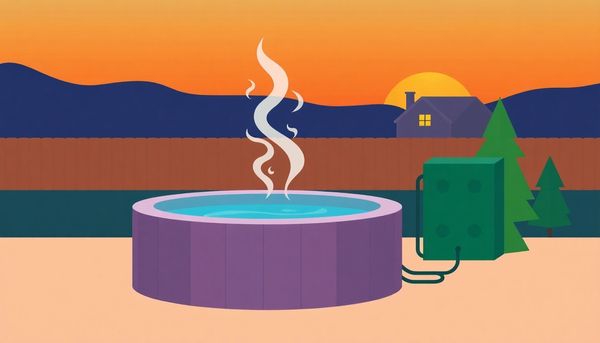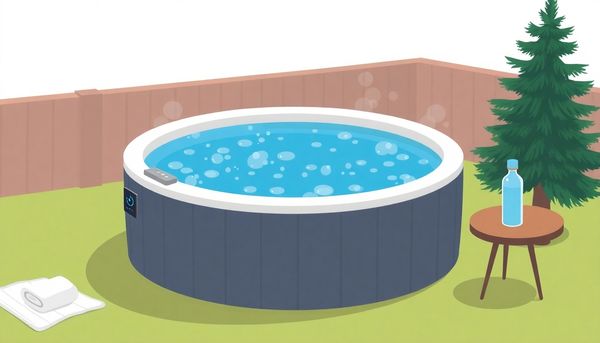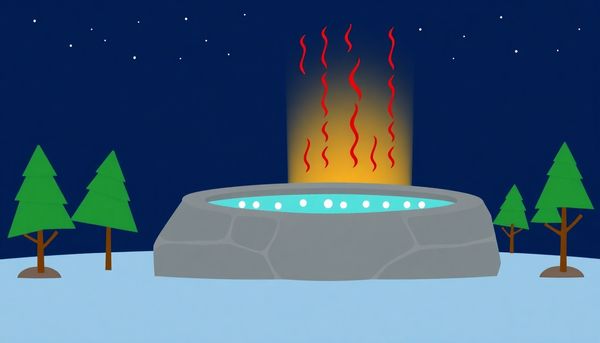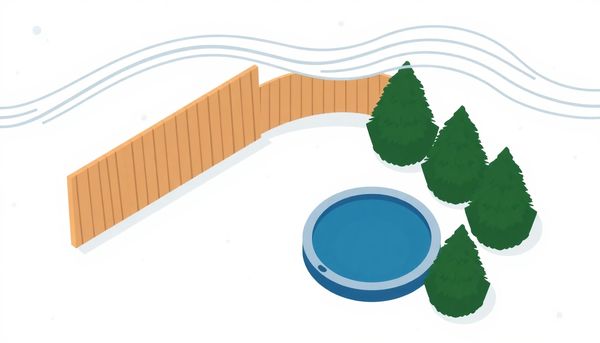Maximize Hot Tub Comfort: Essential Heater and Insulation Tips
April 25th, 2024
April 25th, 2024
A hot tub isn't just a luxurious addition to your backyard; it's a sanctuary, a retreat from the daily grind where the stress of the world dissolves with each bubbling jet. But the magic behind that soothing warmth lies in the often-overlooked hero of the hot tub: the heater. Remember the first time you sank into perfectly warm water on a chilly evening? That comforting embrace was courtesy of a well-functioning heater, a vital component that can elevate or diminish your entire experience.
Understanding the nuances of hot tub heaters opens the door to prolonged bliss and efficiency. Many, like my friend Lucas, initially underestimate its importance until the heater starts acting up, leaving them with a cold, uninviting pool. He once shared his ordeal of stepping into what felt like an ice bath because he neglected regular maintenance. Such experiences underscore the need for knowledge and care.
Whether you're contemplating a purchase or curious about maximizing your current setup, knowing your heater's capabilities and limitations can prevent future headaches. From electric to gas heaters, each type has its quirks and benefits, tailored to various lifestyles and climates. This guide aims to be your compass in navigating these waters, ensuring that your hot tub remains a haven of warmth and relaxation year-round.

In the realm of hot tub ownership, selecting the perfect heater can transform a mundane soak into a blissful retreat. While each tub comes equipped with a standard heater, it doesn't mean you have to stick with the default. Consider your heater like the heart of your hot tub—it powers everything, from the warmth that envelops you to the energy bills that follow.
Factors such as your climate, frequency of use, and budget play a crucial role in your decision. If your spa is nestled in a chilly locale, an energy-efficient model that heats quickly might be your best bet, saving both time and money. For those in milder climates using the tub sporadically, a basic model may suffice, but an upgrade could enhance efficiency and bring down costs in the long term.
Once, I swapped out my old clunker for a sleek, modern unit that not only reached the desired temperature faster but also cut my energy bill substantially. Newer models often come with digital thermostats and advanced flow sensors, ensuring consistent warmth without unnecessary energy waste. Plus, many options are compact and easy to install, fitting snugly into existing setups without hassle.
Ultimately, the right heater is an investment in comfort and sustainability. Evaluate your needs, research your options, and choose a heater that turns every soak into an unforgettable escape.
In the realm of hot tub enjoyment, the magic happens when the temperature is just right. To achieve this, optimizing heating efficiency becomes crucial. Start by ensuring your hot tub cover is in prime condition. A snug, well-insulated cover traps heat, reducing the energy needed to maintain your desired warmth. I remember replacing my worn-out cover with a custom-fit option, and the difference was almost immediate; the heater cycled less frequently, and my energy bill thanked me.
Strategically positioned windbreaks can also play a vital role. Shield your spa from chilly gusts with carefully planted shrubs or privacy screens. During a particularly blustery winter, I set up a simple lattice with climbing plants, which not only kept the wind at bay but also added a bit of charm to the patio.
Regular maintenance is your best ally in keeping the heater efficient. Clean the filter routinely; a clogged filter forces the heater to work overtime. One time, I neglected this step, and the heating time doubled. A swift clean-up returned everything to normal.
For those ready to invest, consider an upgrade to a more efficient heater model, like an EcoSmart or Hayward unit. These newer models often come with digital thermostats and advanced flow sensors, offering precise temperature control and reducing the likelihood of overheating. By incorporating these strategies, you ensure your hot tub is always ready for a relaxing soak, no matter the season.
When the chill of winter starts nipping at your toes, the prospect of a hot tub soak becomes an irresistible allure. But who wants to wait hours for the water to warm up? Upgrading your hot tub heater might be the ticket to faster heating and a more energy-efficient spa experience.
Consider this: a friend of mine recently swapped out her standard heater for an advanced model. She was amazed at the difference. Her new heater not only halved the heating time but also reduced her energy bills significantly. By upgrading to a modern, efficient heater, you might experience similar benefits. Faster heating not only saves time but reduces the energy required to maintain the perfect soak temperature, whether it's a brisk evening or a balmy day.
Imagine cutting down the wait time from hours to just a brisk coffee break. The secret lies in selecting the right heater. Options like the Eco Smart Spa Heater, with its digital thermostat and flow sensor technology, offer precise temperature control while preventing common technical mishaps. Alternatively, Raypak's compact gas heaters deliver reliable heat quickly with minimal energy use.
Each upgrade can make your hot tub more responsive to your needs and adapt better to varying weather conditions. So, while you're considering ways to trim your energy bills, don’t forget the potential of a heater upgrade—because a little investment now could mean countless cozy nights ahead.
In the quest for the perfect hot tub soak, enhancing insulation and coverage emerges as a game-changer. It's not just about the heater, but how you maintain the warmth it generates. Picture those chilly evenings when a hot tub promises relaxation; now imagine losing the precious warmth to the biting cold air. This is where the importance of a robust cover comes into play. A high-quality cover not only retains heat but also shields your tub from external grime and unwanted visitors, like leaves and insects. If your cover appears weathered, consider investing in a new one crafted from marine-grade vinyl, which offers durability and efficient insulation.
Beyond the cover, the structural integrity of your hot tub cabinet can also impact its heating efficiency. Tiny leaks or inadequate insulation within the cabinet can lead to significant heat loss. Implementing additional insulation, such as wall or attic-grade materials within the cabinet, fortifies the tub against external cold, keeping it snug and warm for whenever you’re ready to take a dip.
Further boosting your spa’s warmth, a floating spa cover enhances the primary cover’s insulating power. Simple yet effective, this extra layer can improve the tub’s R-value significantly. Personal experience has shown that this small addition can reduce heating times and energy consumption. So, whether you're a seasoned spa enthusiast or a newcomer, prioritizing insulation can ensure your hot tub is always invitingly warm, ready to offer relaxation at a moment's notice.
There's no denying the pleasure of slipping into a hot tub perfectly warmed to your liking. Yet, the wait for the water to reach its ideal temperature can sometimes feel like an eternity. Fortunately, upgrading your hot tub heater can significantly cut down on waiting time and improve overall efficiency. Much like adding a turbo to a modest engine, an upgraded heater can transform your soaking experience from a slow simmer to a rapid boil.
Consider the case of my friend, Emily, who lives in a region where winters are notoriously harsh. Her evenings often involved enduring extended pre-soak shivers, until she decided enough was enough. She swapped out her old heater for a modern, high-efficiency model. Not only did it reduce the heating time by nearly half, but it also lowered her energy bills. Emily’s hot tub now feels like a welcoming oasis no matter the season, demonstrating how a strategic upgrade can enhance both convenience and cost-effectiveness.
Choosing the right heater requires assessing your specific needs, such as the size of your tub and frequency of use. Look for models that boast advanced features like digital thermostats and robust heating elements. These can offer not only speedier heating but also greater reliability, ensuring that your hot tub is always ready for use when you are. Upgrading is a smart investment, promising faster heat, better efficiency, and a more enjoyable hot-tubbing experience year-round.
A hot tub, with its soothing, warm embrace, can quickly become the centerpiece of relaxation at home. To ensure every dip is as delightful as the last, enhancing the heating efficiency of your hot tub is key. It’s not just about heating faster; it’s about maintaining an optimal temperature with minimal energy loss.
First, consider the heart of your system: the heater. While factory-installed heaters do the job, upgrading to a high-efficiency model can transform your experience. Think of it as swapping out the standard sound system in your car for something that truly rocks. A newer model can bring your tub to the desired warmth faster and more efficiently, saving both time and energy costs.
Next, scrutinize your hot tub cover. A well-maintained cover acts like a cozy blanket, preventing heat from escaping. If your cover has seen better days, a replacement crafted from marine-grade materials could dramatically improve heat retention. Additionally, adding a floating spa blanket can further insulate your tub, cutting heat loss by up to a third.
Beyond equipment, consider the environment. Windbreaks, such as strategically placed screens or hedges, prevent the chilling effect of drafts. These barriers not only conserve heat but also add an element of privacy and aesthetic appeal to your spa area.
Finally, regular maintenance is vital. A clean, well-functioning system ensures that your heater isn’t working overtime due to clogged filters or inefficient components. By combining these strategies, you enhance both the efficiency and enjoyment of your hot tub, ensuring it's always ready for relaxation.
When the urge for a soothing soak strikes, waiting on a sluggish heater can be a buzzkill. For the dedicated hot tub enthusiast, investing in a high-performance heater is akin to swapping a standard stereo for a custom sound system—everything becomes more vibrant and immersive. Just as you wouldn’t settle for tepid tunes, your spa experience deserves the same attention to quality.
Choosing the right heater transforms your tub into a haven of warmth with impressive efficiency. Upgrading might seem daunting initially, but consider the benefits: quicker heating times mean your tub is ready whenever you are, and a more efficient heater reduces energy consumption, lowering those monthly bills. Imagine inviting some friends over to unwind after a long day. With a superior heater, you can be confident the tub will reach that ideal temperature range of 100°F (38°C) to 102°F (39°C) without delay.
In cooler climates, a high-performance heater ensures your hot tub remains a cozy retreat even when the thermometer dips. Think of it as an investment not just in comfort, but in peace of mind. A reliable heater means fewer maintenance headaches, allowing you to focus on what truly matters—enjoying the soothing embrace of your hot tub whenever the mood strikes. So, when pondering your next upgrade, remember that a top-notch heater promises the ultimate in spa satisfaction, all year round.
Ever thought about the little things that make a big difference? Insulating your hot tub effectively is one such unsung hero. When I first got my hot tub, I was all about the bubbles and ambiance, barely giving a thought to how insulation might save me from icy evenings and hefty bills. Yet, as winter approached, I found myself scouring for solutions that wouldn’t break the bank.
Start by checking your hot tub's cover. If it’s seen better days, replacing it can be a game changer. A high-quality cover traps warmth like an invisible guardian, ensuring less heat escapes. On particularly chilly nights, I noticed a significant difference in how quickly my hot tub heated up after I invested in a new cover. It was like wrapping your spa in a cozy blanket.
Beyond the cover, consider adding insulation to the cabinet itself. Some folks, like my neighbor Jerry, who loves a DIY project, swear by layering additional insulation within the cabinet walls. This extra padding not only keeps warmth in but also shields against the biting cold that can creep through tiny cracks and seams.
For those looking to go the extra mile, a thermal blanket floating on the water’s surface is a smart addition. It’s akin to a secondary cover, reducing heat loss and speeding up the heating process. Remember, the right insulation setup doesn’t just preserve heat—it gives you a headstart towards that perfect soak every time.

A hearty soak in a hot tub can melt away stress, but the experience falls flat if the water isn't just right. Ensuring your hot tub maintains an optimal temperature isn't just about comfort—it's about efficiency and safety too. Each hot tub is unique, influenced by its environment and internal components, so understanding these variables is key to a consistently warm experience.
One vital aspect is the ambient temperature. If your hot tub is outdoors, shield it from chilly winds that can sap heat away. Consider installing windbreaks or planting a line of evergreens for natural protection. This not only helps maintain warmth but also enhances privacy and aesthetics.
In the technical arena, regular maintenance of your heater and its components can prevent unwelcome chills. A clogged filter, for instance, restricts water flow, leading to cooler water. Cleaning or replacing filters on schedule ensures the heater functions efficiently. Likewise, inspecting the thermostat and sensors for wear and tear can prevent inconsistent heating—an upgrade here might be worthwhile if your current setup is lackluster.
If you're a DIY enthusiast, fortify your hot tub’s insulation. Adding or upgrading the insulation around the cabinet can reduce heat loss, making it easier and faster to reach your desired temperature. A floating spa cover also acts as an extra barrier against heat escape, effectively enhancing your tub’s energy efficiency.
Ultimately, by marrying smart maintenance with strategic upgrades, you can create a hot tub experience that is reliably warm, inviting, and cost-effective.
A hot tub heater isn't just a component; it’s the heartbeat that keeps those soothing waters invitingly warm. If you’ve ever experienced the agony of slipping into lukewarm water on a chilly evening, the importance of an efficient heater becomes immediately clear. Let me share a story: a friend of mine once upgraded his heater and the transformation was nothing short of magical. His tub went from a sluggish warm-up time to bubbling bliss in a fraction of the time, saving both energy and money.
When considering an upgrade, think about the specifics of your tub’s environment. A heater's performance can vary based on factors like ambient air temperature, the water's starting temperature, and even wind exposure. For instance, if your tub is nestled in a breezy backyard, an energy-efficient model with a robust heating element could be your best ally against the chill.
Moreover, modern heaters offer advanced features like digital thermostats and improved insulation, ensuring consistent temperatures and minimizing heat loss. Some even incorporate novel technologies to reduce wear and tear on the elements, enhancing longevity.
Ultimately, a heater upgrade isn’t just about speed. It’s about creating an oasis tailored to your needs, where relaxation is never compromised by shivers. Whether you’re soaking alone or hosting a gathering, a superior heater turns ordinary moments into extraordinary escapes.
When it comes to keeping your hot tub warm and inviting, insulation plays a pivotal role. Think of insulation as your spa's cozy blanket, safeguarding its warmth against the chilly grip of winter air. The more efficiently your hot tub retains heat, the less energy—and time—it will take to reach your ideal soak temperature. This is especially crucial if you reside in regions where temperatures like to take a nosedive.
One personal tip from a fellow spa enthusiast: evaluate the state of your hot tub’s insulation regularly. My own experience involved adding a layer of attic insulation to the interior side panels of my hot tub cabinet, which noticeably improved heat retention. On particularly frigid nights, a floating thermal blanket cranks the insulation up a notch. These crafty covers lay directly on the water’s surface, trapping steam and warmth that would otherwise escape.
Improperly insulated tubs can suffer significant heat loss, akin to leaving a window open on a cold day. To combat this, ensure your hot tub cover is in good condition, free of rips or water-logged foam. Replacing an old cover might seem like an upfront expense, but the savings on your energy bill—and the enhanced efficiency—make it a wise investment. Whether you're a novice or a seasoned spa master, bolstering your hot tub's insulation can transform your soak from a strategic energy guzzler to a bastion of warmth.
In the quest for a cozy soak, optimizing your hot tub’s surroundings plays a crucial role in efficiency. Often, factors outside the tub can influence how long it takes to reach your desired temperature. Wind is a notorious heat thief, whisking warmth away before you can even step in. A strategic approach to landscaping can mitigate this. Consider planting a row of dense shrubs or trees around your hot tub area. Not only do they provide a natural windbreak, but they also enhance privacy and aesthetic appeal.
Beyond nature’s barriers, physical structures can work wonders too. Installing a screen or gazebo can shelter your spa from unpredictable weather. This added layer acts as both a visual and thermal shield, ensuring heat stays where you want it. Materials like bamboo or treated wood can blend seamlessly with outdoor settings, offering style and functionality.
Another smart move involves beefing up insulation. While hot tub covers help retain heat, adding insulation to the cabinet can further reduce heat loss. A little DIY project of lining your hot tub’s inner panel with foam board or fiberglass can pay off. You’ll find that maintaining a steady temperature becomes more energy-efficient, saving both time and money. By taking these steps, you're not just optimizing your hot tub’s efficiency; you're also enhancing your overall soaking experience.

In the realm of hot tubs, efficiency is key, and insulation serves as a quiet hero. A well-insulated hot tub not only retains heat but also reduces energy consumption, saving you precious time and money. Think of insulation as a cozy blanket for your spa, keeping the warmth in and the cold out. This can be particularly valuable during those chilly evenings when you’re eager for a soak without a lengthy wait.
Variety abounds when it comes to insulation solutions. For instance, adding foam insulation to the inside of your hot tub cabinet can significantly enhance its ability to maintain temperature. It acts as a barrier, preventing the warm air from escaping and cold air from seeping in. Additionally, applying a blanket cover over your existing spa cover can amplify your tub’s insulation efficiency, often boosting the R-value—the measure of thermal resistance—by nearly 30%.
Cover maintenance is equally crucial. Over time, your hot tub cover can become worn or damaged, diminishing its effectiveness. Regularly inspecting and replacing it when necessary ensures that your spa remains at its optimal temperature faster and with less energy expenditure. Investing in a high-quality cover, crafted from marine-grade materials, can further enhance insulation.
These thoughtful upgrades not only elevate your hot tub experience but also contribute to a more sustainable use of resources. With the right insulation strategies, your spa becomes a haven of efficiency and warmth, ready whenever you are.
Upgrading your hot tub heater is like swapping out the old speakers in your car for a state-of-the-art sound system; it transforms the entire experience. A new heater can bring your tub from lukewarm to luxurious, warming the water more swiftly and using energy more efficiently. This not only minimizes waiting time but also reduces electricity bills. Consider your current usage patterns: if you frequently indulge in late-night soaks or have an unpredictable schedule, a more efficient heater could be a game changer.
Take my friend Steve, for instance. Every winter, he dreaded the lengthy wait for his outdoor hot tub to heat up while snowflakes kissed the water's surface. After upgrading to a high-efficiency heater, he now enjoys near-instant warmth, even on the chilliest evenings. The right heater doesn’t just warm water; it warms moments, making every soak a seamless part of your day rather than an event requiring hours of planning.
Moreover, while the heater is the heart of your spa, keep an eye on other elements like insulation and your hot tub cover. Combining a new heater with a well-insulated spa cabinet and a snug-fitting cover can maximize your energy savings. This approach not only enhances comfort but also extends the life of your beloved tub. Embrace the upgrade—your future self, basking in delicious warmth, will thank you.
When your goal is to enjoy a warm soak in record time, enhancing your hot tub's heat retention strategies becomes essential. Start by considering a high-quality cover. A snug-fitting, insulated cover not only keeps debris out but also traps the heat, reducing energy consumption. My old spa cover had seen better days, and swapping it out for a new, custom-fit cover made a noticeable difference in maintaining temperature and reducing the heating time.
Beyond the cover, think about your hot tub's environment. Wind is a notorious heat thief. Strategically planting hedges or setting up windbreaks can significantly cut down on cooling breezes. In my own backyard, a row of dense evergreens not only shielded the hot tub from the wind but added a touch of natural beauty and privacy.
For those in colder regions, additional insulation can be a game-changer. Consider adding insulation to the cabinet panels of your tub. A DIY cabinet surround filled with foam insulation transformed my winter soaking experience. It kept the tub toasty and ready to use without the long wait.
Lastly, a floating thermal blanket can be a worthy investment. This extra layer floats on the water surface, further minimizing heat loss. My friend calls it her secret weapon against cold snaps, and swears by the faster heat-up times she now enjoys. By combining these strategies, your hot tub can maintain its warmth more efficiently, allowing for spontaneous and delightful soaks.
Adjusting your hot tub’s surroundings can be the game-changer you didn’t know you needed. Not only does this make for a more aesthetically pleasing space, but it also enhances the efficiency of your hot tub heater, reducing both wait time and energy costs. Think of it like setting the stage for a performance: the better the backdrop, the more seamless the show.
Start by considering the landscape. Planting shrubs or trees around your hot tub acts as a natural windbreak, which not only adds privacy but also shields the water from cooling breezes. On one particularly blustery winter evening, I noticed a significant temperature drop in my tub. A quick addition of strategically placed potted plants made a noticeable difference, cutting down the wind and helping the water retain its warmth.
Next, evaluate your hot tub's insulation. Many hot tub owners overlook the importance of quality insulation beneath and around the tub. Adding extra layers, such as foam panels within the cabinet, can keep the heat where it belongs—inside the tub. It’s a simple DIY project that can make a world of difference, especially in colder climates.
Finally, consider adding a gazebo or an overhead structure. This not only creates a cozy, sheltered space but also helps protect your hot tub from the elements, reducing heat loss from rain or snow. In the end, optimizing your surroundings is less about the hot tub itself and more about creating the perfect environment for relaxation and efficiency.

Nestled away from prying eyes and buffeting winds, a strategically-placed windbreak can transform your hot tub oasis into a private, serene haven. Beyond just adding to the ambiance, windbreaks play a pivotal role in enhancing both the privacy and efficiency of your hot tub experience. When I first installed my hot tub, I noticed the persistent breeze not only chilled the water faster but also whisked away the comforting steam. A simple addition of tall shrubs changed everything, creating a cozy cocoon that retained warmth and provided a much-needed shield from the elements.
Planting dense bushes or slender trees around your hot tub area can significantly cut down on wind gusts, while simultaneously upping the tranquility factor. Evergreen species, with their year-round foliage, make excellent natural screens. Alternatively, installing wooden or bamboo screens offers a versatile solution, not just blocking wind but also adding a touch of elegance to your setup. These barriers aren't just about functionality; they also enhance the aesthetic appeal, blending seamlessly with your garden decor.
When considering windbreaks, think of them as multi-taskers. They provide a barrier against nosy neighbors, reduce noise, and even protect your tub from unwanted debris. Investing in well-thought-out windbreaks not only improves your hot tub experience but also adds value to your outdoor space, creating a personal sanctuary that invites relaxation any day of the year.
A gusty breeze might feel invigorating when you're out for a stroll, but it’s the enemy of efficient hot tub heating. I remember a chilly autumn evening, eager to unwind in my hot tub, only to discover the heater working overtime just to maintain a cozy temperature. That's when I learned the value of windbreaks.
Creating a barrier around your hot tub can significantly reduce heat loss, keeping your energy bills down and your water warm. Start with a strategic layout of evergreen shrubs or decorative grasses. Not only do they provide aesthetic value, but they also form a natural shield against the wind. You could also consider custom-built screens or lattice panels, tailored to your outdoor space. These not only block the wind but also offer a bit of privacy—ideal for those quiet soak sessions.
For those who like DIY projects, building a wooden fence around the tub area is another effective solution. This not only combats wind but also adds a rustic charm to your backyard oasis. A friend once installed a bamboo curtain, which turned her patio into a serene retreat while cutting down on the cold drafts.
Remember, a well-chosen windbreak doesn’t just keep warmth in; it enhances the ambiance of your hot tub area, making each soak more luxurious and enjoyable.
Enhancing your outdoor space with thoughtful landscaping can transform your hot tub experience into a serene escape. Rather than simply focusing on aesthetics, consider how strategic plantings can offer both privacy and improved efficiency in maintaining your hot tub's temperature. I remember visiting a friend's backyard oasis where they had cleverly arranged a mix of evergreens and tall grasses around their spa. Not only did it create a lush, secluded retreat, but it also acted as a natural barrier against chilling winds, reducing heat loss and energy consumption.
Choosing the right plants is key. Hardy shrubs like boxwood or bamboo can form dense screens, while fast-growing trees such as Leyland cypress or arborvitae provide vertical coverage without taking years to mature. These green walls offer more than just privacy; they create a microclimate, shielding your hot tub from harsh weather and helping to keep the water warm for longer periods.
For those who prefer a more structured solution, installing privacy screens or decorative panels can complement your landscaping efforts. Options made from wood, metal, or even frosted glass can add an element of style while serving as effective windbreaks. Whether you go for natural greenery or architectural features, enhancing the area around your hot tub not only elevates your relaxation experience but also plays a pivotal role in energy efficiency.

This article provided insights into maintaining your pool. Start your pool care journey today!
Want to become a pool maintenance expert? Our free Pool School course covers everything you need to know about pool care. From basic maintenance to advanced troubleshooting, you'll learn how to:
Join over 10,000 pool owners who have already transformed their pool care routine. Get started with our free Pool School course today!